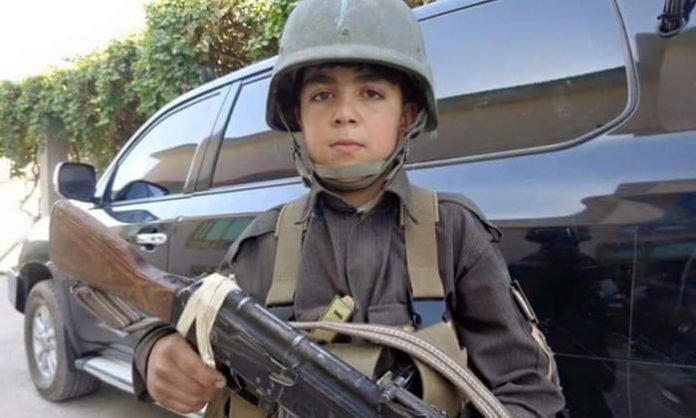An Al Jazeera documentary shows that Islamic State of Khorasan (ISK), the ISIS branch active in Afghanistan and Pakistan, trains children above three years of age to make them fighters. However, these children are not only fighters but also constitute the main victims of the ongoing conflict in the region as reflected in a recently published report of the UN Assistance Mission in Afghanistan (UNAMA). The report shows that only in the first three months of 2019, 150 children have been killed and 432 injured. In other words, the long-lasting conflict in Afghanistan has not only exposed children to the dangers of war but also they have been used as soldiers by the Taliban and the ISIS. Thus, child soldiers have been a part of the ongoing conflict in the country.
In the modern history of Afghanistan, using children as soldiers goes back to the 1980s when the Soviet-backed government established the Democratic Youth Organization (DYO) which recruited children between 10 to 15 years old as soldiers and spies. It is consistent with Lenin’s view that saw youths as the main force of carrying the revolution. About 25,000 to 30,000 Afghani youths were sent to the Soviet Union from 1979 to 1986 for educational purpose. Later on, these children were used by the Soviet Union as spies and soldiers. In the 1980s, the anti-Soviet mujahedeen captured ‘child soldiers’ aged between eight and 15 years old, who had been trained in the Soviet Union for espionage and assassination of the resistance commanders. The children were not only used as fighting forces by the Soviet Union but also the Afghan Mujahedin hired them to fight against the Soviet Union and the Kabul government.
According to the Middle East Institute report, during the decade of war following the Soviet invasion of Afghanistan in 1979, an estimated 1.8 million people were killed, 1.5 million disabled (among whom were more than 300,000 children), and there were 7.5 million refugees. After the Soviet Union’s withdrawal from Afghanistan in 1989, the conflict transformed from being an Afghan Jihad into a civil war. The majority of the Taliban and the anti-Taliban soldiers were no other than the child soldiers of the previous decade. In a 2005 report, the Human Rights Watch concluded that in the civil war of the early 1990s, thousands of people were killed, tortured, raped and disappeared – many of them were children. The Etihad Party of Rasul Sayaff, and Shuraye Nizar, the military wing of Jamiat-e Islami Party, jointly launched the Afshar ethnic pogrom in 1993 in the west of Kabul, where most of the victims were women and children.
After 2001, children have been used in the onging infightings as suicide bombers and soldiers, they also have been its main victims. Based on the United Nation Assistance Mission in Afghanistan (UNAMA) 2016 report, during 2016, Out of the 11,418 noncombatants killed and injured, 3,512 were children. The UN mission report also shows a 65 percent increase in children causalities in the same year.
Using children in war goes against International Humanitarian Law (IHL) which states children under the age of 18 years shall neither be recruited in the armed forces or non-state militia groups nor allowed to take part in hostilities. The Convention on the Rights of the Children (1989) as well as its optional protocol on the Involvement of Children in Armed Conflict (2000) has also specifically emphasized on the need to protect children from the effects of armed conflict.
The conflict in Afghanistan has caused considerable human suffering. The scars of violence are visible amongst the victims’ families, in particular, those who lost their children. But the direct impact of war on children is evident across the country. One cannot help but notice the dire situation of disabled and maimed children who constitute the main part of street beggars and child labors. The current government of Afghanistan neither raises its voice on children causalities nor protects the children from being hired and used as suicide bombers across the country. Instead, organizations like UNICEF, Swedish Committee, Save the Children, Children in Crises and Equal Access have taken measures to educate and protect the affected children.
Despite several peace talks held between the US and Taliban representatives, the future of durable peace, if at all, seems gloomy. The government of Afghanistan and its international backers need to focus on the prevention of recruitment of the children by armed groups and terrorist organizations.
The views and opinions expressed in this article are those of the author and do not necessarily reflect the official policy or position of The Geopolitics.
The author works at Afghanistan’s Forensic Science Organization and teaches at Gawharshad University, Kabul. He graduated by the Department of International Relations, South Asian University, New Delhi.


